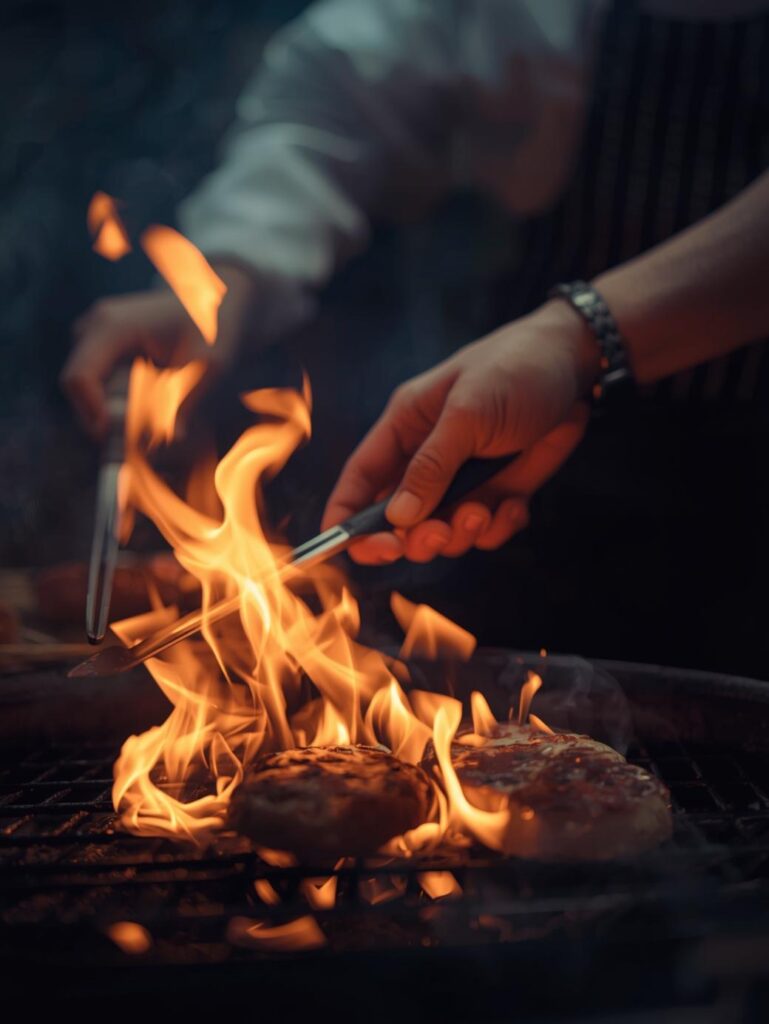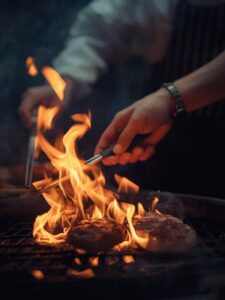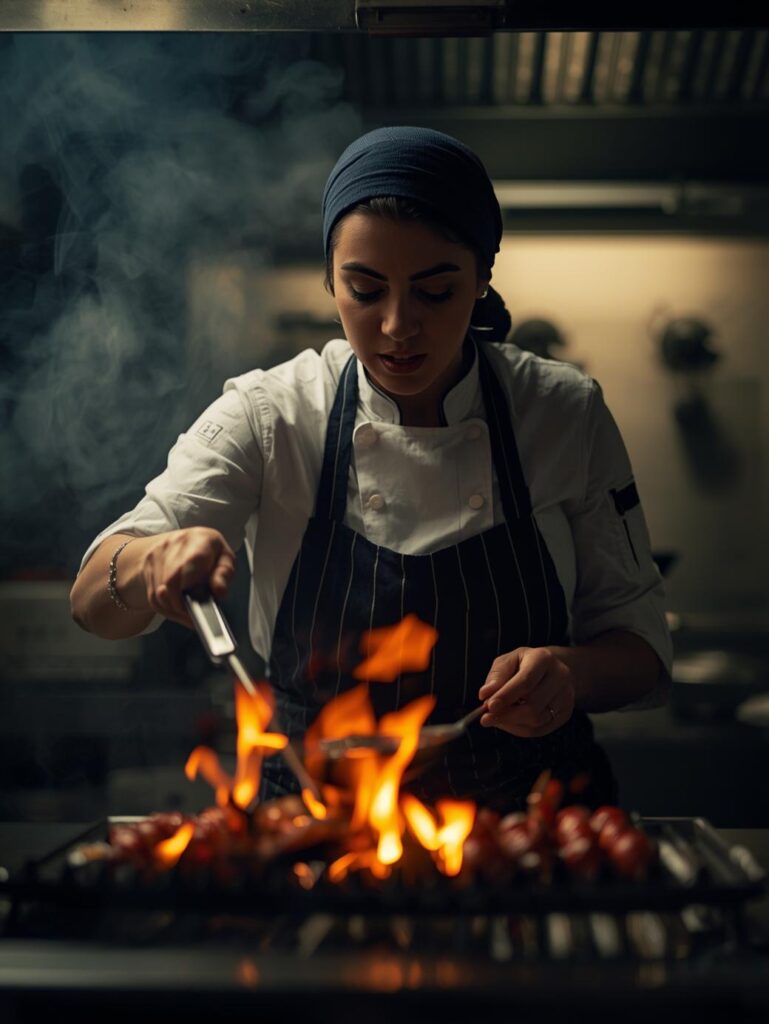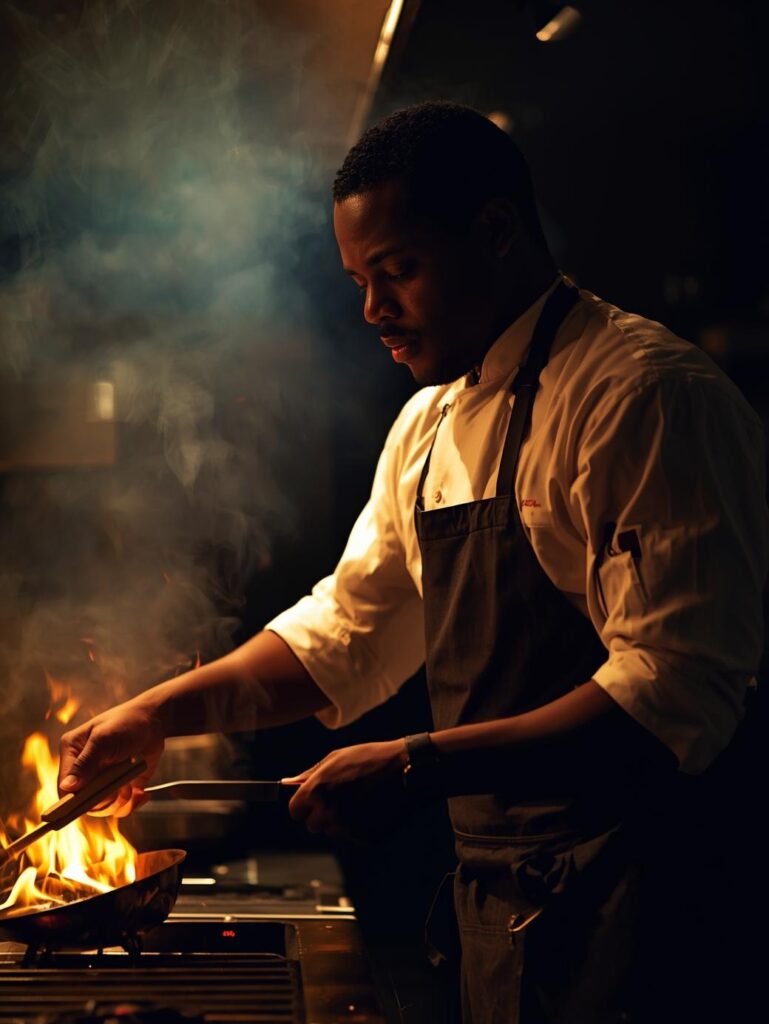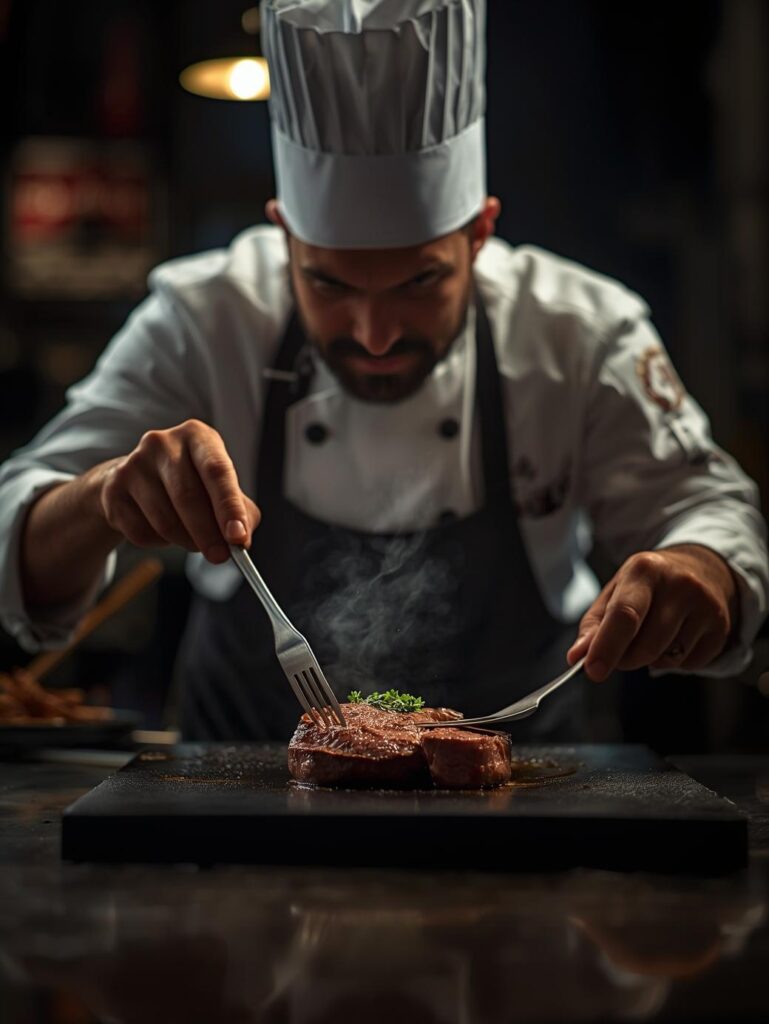Expert’s Note: This guide is part of our comprehensive BBQ Methods & Techniques Encyclopedia. Explore our complete master guide to become a true grilling techniques expert.
Table of Contents Hide ContentsHere’s What Professional Chefs Know About Grill Temperature
There’s a reason why the steak you get at a high-end restaurant is always perfectly cooked, with a deep, savory crust and a juicy, tender interior. It’s not a secret ingredient or a fancy piece of equipment. The biggest difference between a home cook and a professional chef is the mastery of grill temperature. While home cooks often rely on time or a vague sense of “done-ness,” a pro knows exactly how hot their grill is and how that affects the final product.
What Professional Chefs Know About Grill Temperature
Here's What Professional Chefs Know About Grill Temperature
This guide will demystify the art of grill temperature control. We’ll break down the concepts of different grill heat zones, explain what to cook at each temperature, and provide the essential grill temperature tips you need to achieve a perfect result every time. By the end, you’ll be cooking with the precision and confidence of a seasoned chef.
New to temperature control? Start with these essential guides:
🌡️ Temperature Mastery
- 📊 Meat Temperature Guide – Safe internal temps for every cut
- 🔥 Two-Zone Grilling – Master heat zone control
- 🎯 Best Thermometers – Tools for perfect results
- ❌ Common Mistakes – Avoid temperature errors
The Core Principle: Temperature is the Secret
Everything that happens to your food on the grill—from the sear to the flavor to the tenderness—is a direct result of temperature. It’s what causes the Maillard reaction that creates a beautiful crust on a steak. It’s what breaks down tough connective tissues in a brisket to make it tender. If you want to cook like a pro, you must stop guessing and start controlling the heat.
The Two Heat Zones: The Foundation of Grilling
Before you can master different temperatures, you need to understand how to create them. Every professional griller uses a two-zone setup, even on a gas grill.
Direct Heat: This is the hot zone, where the food is placed directly over the heat source (flame or coals). This is for searing, getting a good crust, and cooking food that doesn’t take long to cook.
Indirect Heat: This is the cooler zone, where the food is placed to cook without direct heat from below. This is for roasting, smoking, and finishing larger cuts of meat.
This is a fundamental concept that we cover in our guide, What’s the Difference Between Grilling and Barbecuing?, as it’s the key to making any grill work for any kind of cook.
Master Your Equipment: Get the right tools for perfect temperature control:
Grill Gear Guide
- Grill Types Compared – Choose your perfect grill
- Essential BBQ Tools – Must-have temperature gear
- Temperature Control – Master heat management
- Grill Maintenance – Keep equipment performing
A Chef’s Guide to Grilling Temperatures
A professional chef doesn’t think in terms of “high” or “low” heat; they think in terms of specific temperature ranges. Here is a breakdown of the three primary grill temperature zones and what to cook in each.
1. High Heat (450°F-550°F): The Searing Zone
This is the zone for a hot and fast cook. The goal here is to create a deep, beautiful sear on the outside of your food without overcooking the inside.
What to Cook: Steaks, burgers, hot dogs, and quick-cooking vegetables like asparagus.
Why It Works: High heat is what causes the Maillard reaction, the chemical process that creates a deep, brown crust and hundreds of complex flavor compounds. This is also the ideal grill temperature for a quick cook, as it gets your food cooked quickly before it has a chance to dry out.
2. Medium Heat (350°F-450°F): The All-Purpose Zone
This is the most versatile grill temperature range. It’s perfect for cooking things that are too thick for high heat but don’t need the low-and-slow treatment.
What to Cook: Pork chops, sausages, thicker chicken breasts, and fish fillets.
Why It Works: Medium heat allows the food to cook all the way through without burning the outside. It’s the perfect compromise between speed and control.
3. Low Heat (225°F-350°F): The Low and Slow Zone
This is the zone for a marathon cook. The goal is to gently cook the meat over a long period to break down tough connective tissues and infuse it with smoky flavor.
What to Cook: Ribs, pork shoulder, brisket, and whole chickens.
Why It Works: The low temperature is what turns tough collagen into gelatin, resulting in tender, juicy meat. This is the secret to a perfect pulled pork or a rack of ribs. Using this technique is the key to preventing common mistakes like the ones in our guide, 5 Chicken Grilling Mistakes That Cause Dryness.
| Grill Temperature | Temperature Range | Foods to Cook | Primary Purpose |
|---|---|---|---|
| High | 450-550°F | Steaks, burgers, hot dogs | Searing & crust development |
| Medium | 350-450°F | Pork chops, chicken, fish | All-purpose cooking |
| Low | 225-350°F | Brisket, ribs, pulled pork | Tenderizing & smoke infusion |
Running into temperature issues? Solve common grilling problems:
Troubleshooting
- Tough Meat Fix – Solve overcooking problems
- Prevent Sticking – Temperature-related solutions
- Steak Mistakes – Avoid common errors
- Resting Guide – Complete the cooking process
The Ultimate Tool for Grill Temperature Control: The Thermometer
A professional chef would never cook without a thermometer, and neither should you. The gauge on your grill lid is often wildly inaccurate and only measures the air temperature, not the temperature of your cooking surface.
The Probe: Use a reliable instant-read digital thermometer to check the internal temperature of your food. This is the only way to ensure your food is both safe to eat and perfectly cooked. We stress this point in our guide on 10 Grilling Errors That Ruin a Perfect Steak.
The Grill Thermometer: Consider a separate, reliable grill thermometer to measure the air temperature near the grates. This will help you achieve the perfect grill temperature you’re aiming for.
Practical Grill Temperature Tips
Preheat! A preheated grill is the key to maintaining a consistent temperature. A cold grill is hard to control.
Adjust Early: It takes time for a grill to heat up or cool down. Make small adjustments to the heat early on, not when you’re in a panic.
Use Your Vents: For charcoal grills, the vents are your primary tool for grill temperature control. Open them to increase airflow and temperature, close them to decrease it.
Listen to the Food: Learn to listen to your food. A high-heat sear should sound like a sizzle. If you hear a loud hissing, the temperature is too high.
FAQ: What Professional Chefs Know About Grill Temperature
1. What is the main difference between a chef’s approach and a home cook’s approach to grill temperature?
A professional chef sees grill temperature as the most important variable to control. They cook to a specific internal temperature, using a thermometer, rather than relying on time or a vague sense of “doneness” like many home cooks.
2. What is the perfect grill temperature?
There is no single perfect grill temperature. It depends on what you are cooking. A high temperature (450°F+) is perfect for searing steaks, while a low temperature (225-275°F) is perfect for slow-cooking ribs.
3. How can I tell how hot my grill is without a thermometer?
You can use the hand test. Hold your hand about 5 inches above the cooking grates. If you can hold it there for 2-4 seconds, it’s high heat. 5-7 seconds is medium, and 8-10 seconds is low. However, this method is not precise.
4. What are the grill heat zones?
The grill heat zones refer to the different temperature areas on your grill. A two-zone setup is standard, with a direct heat zone (hot) and an indirect heat zone (cool).
5. Does a gas grill have better temperature control than a charcoal grill?
A gas grill is generally easier to control. A charcoal grill requires more practice to control, as you have to adjust the vents and the amount of charcoal.
6. Why is it so important to know the internal temperature of my food?
Knowing the internal temperature is the only way to ensure your food is cooked safely and to the desired doneness. For example, a steak cooked to 135°F will be medium-rare, while a chicken breast cooked to 165°F will be safe to eat.
7. What’s the biggest mistake people make with grill temperature?
The biggest mistake is overcooking. Many people are afraid of undercooked meat, especially with chicken, and end up cooking it at too high a temperature for too long, resulting in a dry, tough final product.
Now that we’ve covered the most common questions… Let’s bring it all together with our final thoughts on mastering grill temperature like a pro.
Conclusion
The secret to a perfectly cooked meal on the grill isn’t a secret at all. It’s the mastery of grill temperature. By understanding the different heat zones and using the right tools, you can move from a home cook who hopes for a good result to a professional who knows they’ll get one every time. The next time you fire up the grill, remember these grill temperature tips and take control. Your taste buds will thank you.
Ready to Master Grill Temperature?
Join thousands of grill masters who are achieving perfect results with our proven temperature techniques and equipment guides.
Master Temperature Control: Explore our complete BBQ education resources:
Continue Your BBQ Journey
Temperature Mastery
Grilling Techniques
Equipment Guides
Problem Solving
🔗 Official Resources & References
For additional food safety guidelines and official standards, consult these authoritative sources:
-
🏛️ USDA Safe Minimum Internal Temperature Chart
Official government temperature guidelines for meat safety
📋 FDA Food Safety Modernization Act
Federal food safety regulations and standards
-
🎓 Penn State Food Safety Extension
University research on food safety and meat science
🔬 American Meat Science Association
Professional organization for meat science research
🔥 Barbecue Industry Association
Industry standards for barbecue food safety
These external resources provide additional authoritative information on food safety standards and regulations.

